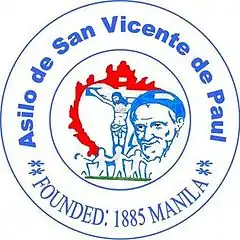Asilo de San Vicente de Paul
Asilo de San Vicente de Paul is an orphanage located on UN Avenue in Manila, Philippines. It is run by the Daughters of Charity of Saint Vincent de Paul.
| Asilo de San Vicente de Paul | |
|---|---|
 Logo of the organization | |

| |
| Former names | Casa de San Vicente de Paul |
| Alternative names | Looban Convent;[1] Asilo de Looban[2] |
| General information | |
| Coordinates | 14.584108°N 120.990564°E |
| Completed | 1885 |
| Renovated | 1945 |
History
Asilo de San Vicente de Paul (ASVP), formerly known as Casa de San Vicente de Paul, was founded on 26 July 1885 by Sr. Asuncion Ventura, DC, a native of Bacolor, Pampanga. She donated an inheritance from her family to the Daughters of Charity and purchased a lot of 6 hectares of land for a building where she established the asylum for girls, making her the first Filipina to build an orphanage in the country.[3][4]

ASVP started with only 33 wards, catering to girls who were orphans or homeless. Later on, it expanded its services into providing education and training to young girls, particularly on embroidery and needlework, which has become a distinction of the institution. The Spanish government provided a monthly supply of 20 cavans of rice to the orphanage, which was later continued by the Americans until government aid to charitable institutions was ceased due to the prohibition dictated by the Jones Law.[3] Over time, ASVP has sold portions of land until today it retains two hectares for the institution.[5]
In the early days, affluent families visited ASVP to purchase the embroideries of the girls. Others come to the institution to select wives for their sons. The mother of former Philippine First Lady Imelda Marcos, Remedios Trinidad, used to be a ward at the ASVP, also known then as Looban Convent, from where the mother of Orestes Romualdez found Trinidad and was introduced to Romualdez.[1]
In 1935, ASVP was given a marker by the Historical Research and Markers Committee.[6]
In 1942 during World War II Manila was bombed leading to the burning of the ASVP building, where according to ASVP, 200 people died.[3] The structure was rebuilt in February 1945.[3] One of the benefactors of ASVP in its rebuilding was Don Teodoro V. Santos (1915-1983), who was a devout Catholic and philanthropist.[7]
For a time, ASVP also operated as an educational institution but the school was gradually closed between 1982 and 1999 and ASVP focused on its role in child care. It was also the temporary home of another institution, Tahanan Sta. Luisa, for the years 2000-2002.[8]
See also
References
- Ellison, Katherine (2005). Imelda: Steel Butterfly of the Philippines. iUniverse. p. 12. ISBN 9780595349227.
- A Directory of Charitable and Social Service Organizations and Institutions in the City of Manila, Second Edition (Revised). Manila: Bureau of Printing. 1929. p. 29. Retrieved 17 November 2014.
- "Its Beginnings". Asilo Manila. Asilo de San Vicente de Paul. Archived from the original on 18 July 2014. Retrieved 21 May 2014.
- Tantingco, Robby (5 March 2009). "Kapampangan women make mark in history". Philippine Star. Philippine Star. Retrieved 15 November 2014.
- De La Torre, Visitacion R. (1981). Landmarks of Manila, 1571–1930. Manila, Philippines: Filipinas Foundation for Security Bank and Trust Company. p. 155. Retrieved 17 November 2014.
- "Asilo of San Vicente de Paul". National Registry of Historic Sites and Structures in the Philippines. National Historical Commission of the Philippines. Retrieved 21 May 2014.
- "The History Behind DTVSI". Don Teodoro V. Santos Institute. Don Teodoro V. Santos Institute. Archived from the original on 20 November 2014. Retrieved 17 November 2014.
- "Past and Present". Tahanan Sta. Luisa. Retrieved 15 November 2014.
External links
| Wikimedia Commons has media related to Asilo de San Vicente de Paul. |